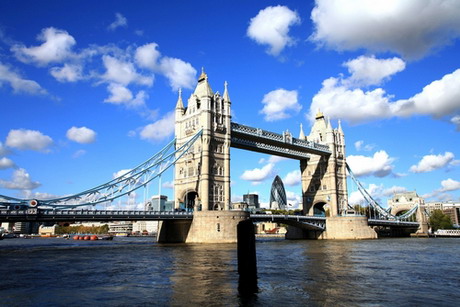|
Гіпермаркет Знань>>Англійська мова>>Англійська мова 9 клас>>Англійська мова: UK
England
England, the largest and most populous portion of the United Kingdom of Great Britain and Northern Ireland (1991 pop. 46,382,050), 50,334 sq mi (130,365 sq km). It is bounded by Wales and the Irish Sea on the west and Scotland on the north. The English Channel, the Strait of Dover, and the North Sea separate it from the continent of Europe. The Isle of Wight, off the southern mainland in the English Channel, and the Scilly Islands, in the Atlantic Ocean off the southwestern tip of the mainland, are considered part of England. London, the capital of Great Britain, is located in the southeastern portion of England. The Thames and the Severn are the longest rivers.
Behind the white chalk cliffs of the southern coast lie the gently rolling downs and wide plains stretching to the Chiltern Hills and the Cotswold Hills. Along the east coast are the lowlands of Norfolk, reaching up to the Fens, formerly marshy country that has been drained, lining The Wash, an inlet of the North Sea. In the east and southeast, river estuaries lead to some of England's great commercial and industrial centers: London, on the Thames; Hull, on the Humber; Middlesbrough and Stockon-on-Tees, on the Tees; and Newcastle upon Tyne, on the Tyne. The north of England, above the Humber, is mountainous; the chief highlands are the Cumbrian Mts. in the northwest and the Pennines, which run north-south in N central England. The famous Lake District, in the Cumbrians, has England's highest points. The center of England, the Midlands, is a large plain, interrupted and bordered by hills. In the Midlands are the industrial centers of Birmingham and the Black Country. The Midlands, especially its northern edge, was formerly a great coal-mining region. On the Lancashire plain is the great city of Manchester, the center of the English textile industry. Durham and W Yorkshire are also highly industrialized, but E Yorkshire is an area of bleak moors and wolds, and the upper reaches of Northumberland are sparsely populated. In the west and southwest the border with Wales and the peninsula of Devonshire and Cornwall have a hilly, upland terrain. The main ports in the west are Bristol, on the Avon (which flows into Bristol Channel), and Liverpool, on the Mersey. In southern England, the main ports are London, Southampton, and Plymouth.
Despite its northerly latitudes (London is on the same parallel as the easterly tip of Labrador), England has a mild climate, attributable to warm currents in the surrounding seas. Most of the region is subject to much wet weather, and some of it experiences severe cold, but in general the climate is favorable to a wide variety of agricultural and industrial pursuits.
England has 36 administrative counties: Bedfordshire, Buckinghamshire, Cambridgeshire, Cheshire, Cornwall, Cumbria, Derbyshire, Devon, Dorset, Durham, East Sussex, Essex, Gloucestershire, Hampshire, Herefordshire, Hertfordshire, Kent, Lancashire, Leicestershire, Lincolnshire, Norfolk, Northamptonshire, Northumberland, North Yorkshire, Nottinghamshire, Oxfordshire, Rutland, Shropshire, Somerset, Staffordshire, Suffolk, Surrey, Warwickshire, West Sussex, Wiltshire, and Worcestershire. The counties are divided into districts. Herefordshire, the Isle of Wight, Rutland have abandoned the two-tier county council–district council structure for a single-tier unitary council. The counties of Avon, Berkshire, Cleveland, and Humberside have been dissolved into smaller unitary authorities; these and other areas that were administratively part of the remaining counties are now independent local governing authorities.
From 1974 to 1986 there were also seven metropolitan counties: Greater London, Greater Manchester, Merseyside, South Yorkshire, Tyne and Wear, West Midlands, and West Yorkshire; the administrative districts that comprised these counties are now responsible for most local government functions. Greater London consists of the City of London and 32 boroughs and, unlike the other former metropolitan counties, has an elected mayor and assembly.
The 39 so-called ancient or geographical counties of England (Bedfordshire, Berkshire, Buckinghamshire, Cambridgeshire, Cheshire, Cornwall, Cumberland, Derbyshire, Devon, Dorset, Durham, Essex, Gloucestershire, Hampshire, Herefordshire, Hertfordshire, Huntingdonshire, Kent, Lancashire, Leicestershire, Lincolnshire, Middlesex, Norfolk, Northamptonshire, Northumberland, Nottinghamshire, Oxfordshire, Rutland, Shropshire, Somerset, Staffordshire, Suffolk, Surrey, Sussex, Warwickshire, Westmorland, Wiltshire, Worcestershire, and Yorkshire) typically differ in area from the existing counties even when they share a name with a modern county. Some ancient counties (Sussex and Yorkshire) have been divided into separate counties or counties and districts, while others (Berkshire, Cumberland, Huntingdonshire, Middlesex, and Westmorland) have seen their names disappear entirely from among the administrative counties.

Если у вас есть исправления или предложения к данному уроку, напишите нам.
Если вы хотите увидеть другие корректировки и пожелания к урокам, смотрите здесь - Образовательный форум.
Предмети > Англійська мова > Англійська мова 9 клас > Тема 4. Повторення теми the United Kingdom > Тема 4. Повторення теми the United Kingdom. Національні особливості
|











